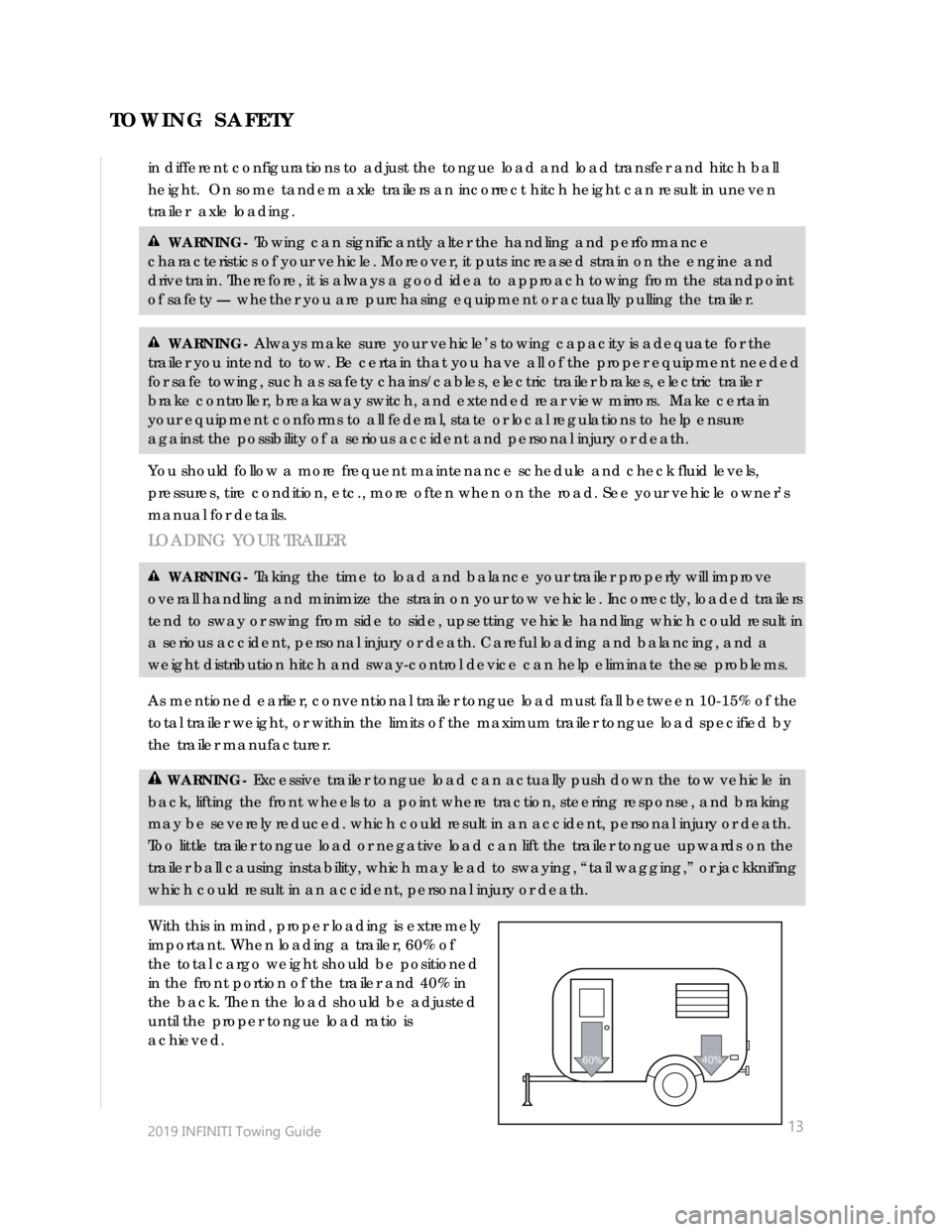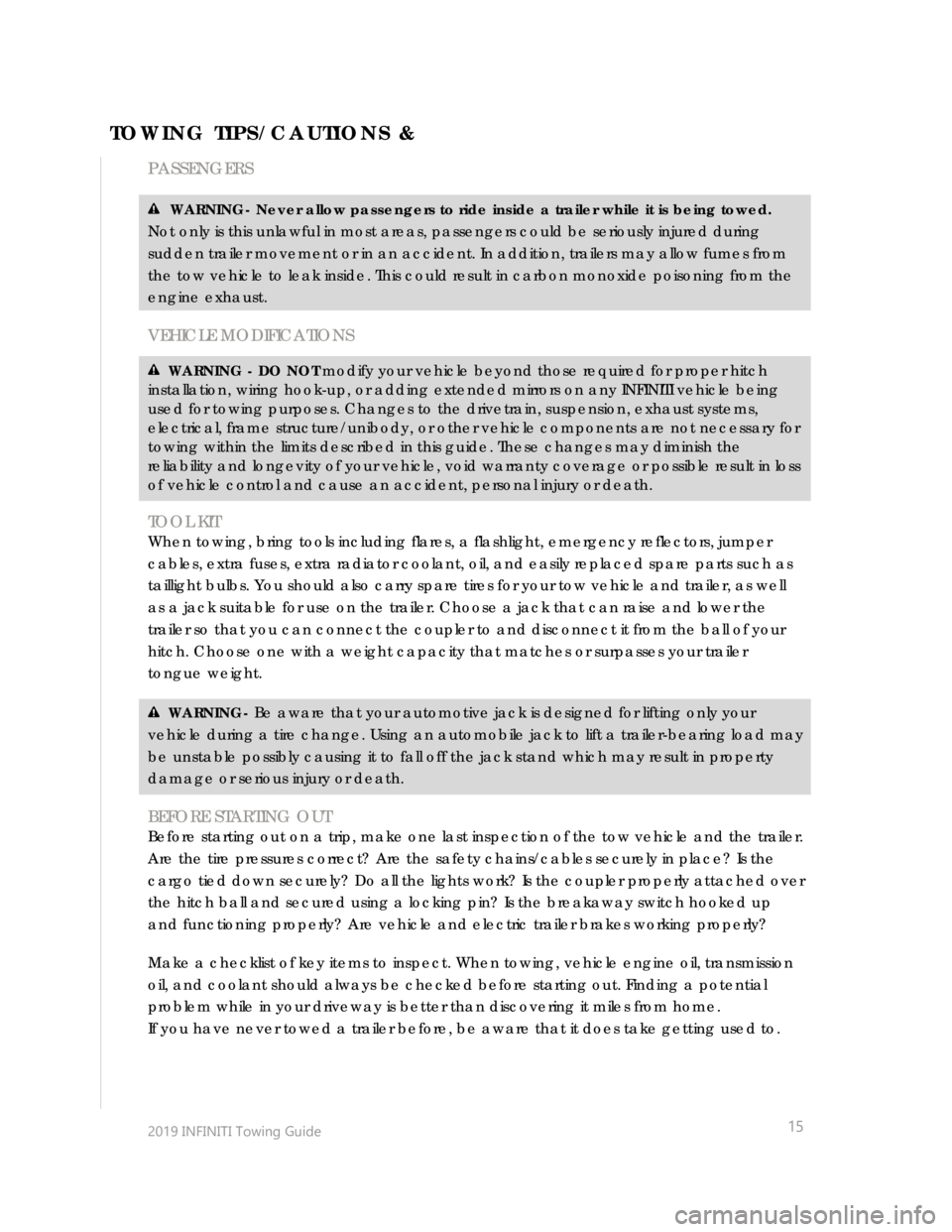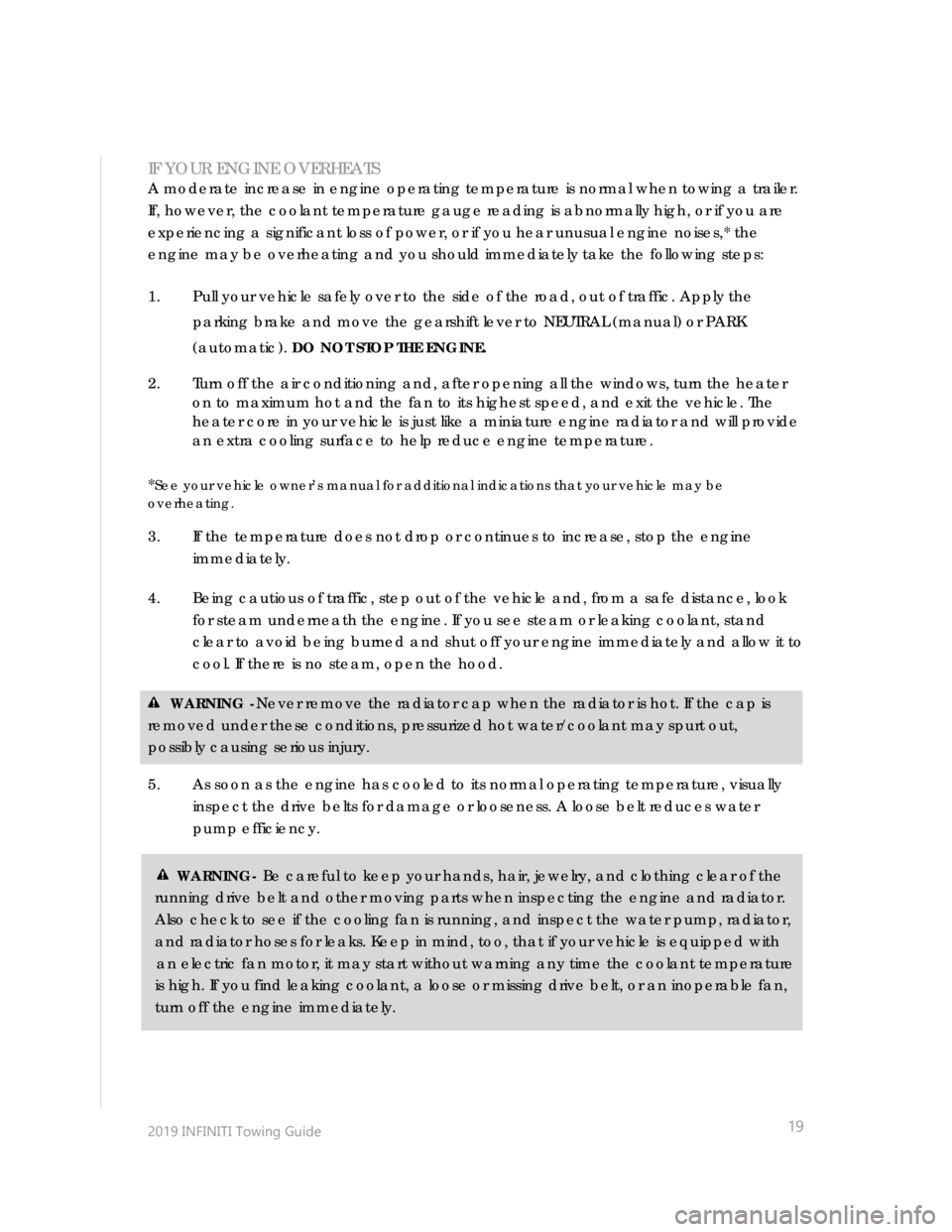check engine INFINITI Q70 2019 Towing Guide
[x] Cancel search | Manufacturer: INFINITI, Model Year: 2019, Model line: Q70, Model: INFINITI Q70 2019Pages: 25, PDF Size: 0.38 MB
Page 14 of 25

2019 INFINITI Towing Guide
13
in different configurations to adjust the tongue load and load transfer and hitch ball
height. On some tandem axle trailers an incorrect hitch height can result in uneven
trailer axle loading.
WARNING- Towing can significantly alter the handling and performance
characteristics of your vehicle. Moreover, it puts increased strain on the engine and
drivetrain. Therefore, it is always a good idea to approach towing from the standpoint
of safety — whether you are purchasing equipment or actually pulling the trailer.
WARNING- Always make sure your vehicle’s towing capacity is adequate for the
trailer you intend to tow. Be certain that you have all of the proper equipment needed
for safe towing, such as safety chains/cables, electric trailer brakes, electric trailer
brake controller, breakaway switch, and extended rear view mirrors. Make certain
your equipment conforms to all federal, state or local regulations to help ensure
against the possibility of a serious accident and personal injury or death.
You should follow a more frequent maintenance schedule and check fluid levels,
pressures, tire condition, etc., more often when on the road. See your vehicle owner’s
manual for details.
LOADING YOUR TRAILER
WARNING- Taking the time to load and balance your trailer properly will improve
overall handling and minimize the strain on your tow vehicle. Incorrectly, loaded trailers
tend to sway or swing from side to side, upsetting vehicle handling which could result in
a serious accident, personal injury or death. Careful loading and balancing, and a
weight distribution hitch and sway-control device can help eliminate these problems.
As mentioned earlier, conventional trailer tongue load must fall between 10-15% of the
total trailer weight, or within the limits of the maximum trailer tongue load specified by
the trailer manufacturer.
WARNING- Excessive trailer tongue load can actually push down the tow vehicle in
back, lifting the front wheels to a point where traction, steering response, and braking
may be severely reduced. which could result in an accident, personal injury or death.
Too little trailer tongue load or negative load can lift the trailer tongue upwards on the
trailer ball causing instability, which may lead to swaying, “tail wagging,” or jackknifing
which could result in an accident, personal injury or death.
With this in mind, proper loading is extremely
important. When loading a trailer, 60% of
the total cargo weight should be positioned
in the front portion of the trailer and 40% in
the back. Then the load should be adjusted
until the proper tongue load ratio is
achieved.
60%40%
TOWING SAFETY
Page 16 of 25

2019 INFINITI Towing Guide
15
PASSENGERS
WARNING- Never allow passengers to ride inside a trailer while it is being towed.
Not only is this unlawful in most areas, passengers could be seriously injured during
sudden trailer movement or in an accident. In addition, trailers may allow fumes from
the tow vehicle to leak inside. This could result in carbon monoxide poisoning from the
engine exhaust.
VEHICLE MODIFICATIONS
WARNING - DO NOT modify your vehicle beyond those required for proper hitch
installation, wiring hook-up, or adding extended mirrors on any INFINITI vehicle being
used for towing purposes. Changes to the drivetrain, suspension, exhaust systems,
electrical, frame structure/unibody, or other vehicle components are not necessary for
towing within the limits described in this guide. These changes may diminish the
reliability and longevity of your vehicle, void warranty coverage or possible result in loss
of vehicle control and cause an accident, personal injury or death.
TOOL KIT
When towing, bring tools including flares, a flashlight, emergency reflectors, jumper
cables, extra fuses, extra radiator coolant, oil, and easily replaced spare parts such as
taillight bulbs. You should also carry spare tires for your tow vehicle and trailer, as well
as a jack suitable for use on the trailer. Choose a jack that can raise and lower the
trailer so that you can connect the coupler to and disconnect it from the ball of your
hitch. Choose one with a weight capacity that matches or surpasses your trailer
tongue weight.
WARNING- Be aware that your automotive jack is designed for lifting only your
vehicle during a tire change. Using an automobile jack to lift a trailer-bearing load may
be unstable possibly causing it to fall off the jack stand which may result in property
damage or serious injury or death.
BEFORE STARTING OUT
Before starting out on a trip, make one last inspection of the tow vehicle and the trailer.
Are the tire pressures correct? Are the safety chains/cables securely in place? Is the
cargo tied down securely? Do all the lights work? Is the coupler properly attached over
the hitch ball and secured using a locking pin? Is the breakaway switch hooked up
and functioning properly? Are vehicle and electric trailer brakes working properly?
Make a checklist of key items to inspect. When towing, vehicle engine oil, transmission
oil, and coolant should always be checked before starting out. Finding a potential
problem while in your driveway is better than discovering it miles from home.
If you have never towed a trailer before, be aware that it does take getting used to.
TOWING TIPS/CAUTIONS &
Page 20 of 25

2019 INFINITI Towing Guide
19
IF YOUR ENGINE OVERHEATS
A moderate increase in engine operating temperature is normal when towing a trailer.
If, however, the coolant temperature gauge reading is abnormally high, or if you are
experiencing a significant loss of power, or if you hear unusual engine noises,* the
engine may be overheating and you should immediately take the following steps:
1. Pull your vehicle safely over to the side of the road, out of traffic. Apply the
parking brake and move the gearshift lever to NEUTRAL (manual) or PARK
(automatic). DO NOT STOP THE ENGINE.
2. Turn off the air conditioning and, after opening all the windows, turn the heater
on to maximum hot and the fan to its highest speed, and exit the vehicle. The
heater core in your vehicle is just like a miniature engine radiator and will provide
an extra cooling surface to help reduce engine temperature.
*See your vehicle owner’s manual for additional indications that your vehicle may be
overheating.
3. If the temperature does not drop or continues to increase, stop the engine
immediately.
4. Being cautious of traffic, step out of the vehicle and, from a safe distance, look
for steam underneath the engine. If you see steam or leaking coolant, stand
clear to avoid being burned and shut off your engine immediately and allow it to
cool. If there is no steam, open the hood.
WARNING -Never remove the radiator cap when the radiator is hot. If the cap is
removed under these conditions, pressurized hot water/coolant may spurt out,
possibly causing serious injury.
5. As soon as the engine has cooled to its normal operating temperature, visually
inspect the drive belts for damage or looseness. A loose belt reduces water
pump efficiency.
WARNING- Be careful to keep your hands, hair, jewelry, and clothing clear of the
running drive belt and other moving parts when inspecting the engine and radiator.
Also check to see if the cooling fan is running, and inspect the water pump, radiator,
and radiator hoses for leaks. Keep in mind, too, that if your vehicle is equipped with
an electric fan motor, it may start without warning any time the coolant temperature
is high. If you find leaking coolant, a loose or missing drive belt, or an inoperable fan,
turn off the engine immediately.
Page 21 of 25

2019 INFINITI Towing Guide
20 6. If no leaks are apparent and all other components appear to be operating
properly with the engine cooled to its normal operating temperature; check the
coolant level in the reservoir tank with the engine running. Add coolant to the
reservoir tank if needed. At this point, if repairs are required, go to the nearest
INFINITI retailer. See the IN CASE OF EMERGENCY section of your vehicle owner’s
manual for additional information on overheating.
NOTE – All INFINITI vehicles have an engine protection mode which helps reduce the
chance of engine damage if the engine coolant reaches a specified temperature.
NOTES
Passenger Vehicles – INFINITI cautions that you do not tow a trailer with Q50, Q60, Q70,
or Q70 (HEV) vehicles.
Cross-Over Vehicles – INFINITI cautions that you do not tow a trailer QX30, QX50, or the
QX70 2WD vehicles.
Other Recommendations and Information – Towing performance and speed are
affected by vehicle payload, tow weight, road grades, and weather conditions,
including high temperatures. See your vehicle owner’s manual for details.
TOWING GLOSSARY
BALL MOUNT A bar that holds the hitch ball and is inserted into the hitch receiver.
Also commonly called a drawbar.
1 Maximum Trailer Weight values are calculated assuming a base
vehicle with driver and any options required, to achieve the
rating. Additional passengers, cargo and/or optional equipment
will add weight to the vehicle and reduce your vehicle’s
maximum towing capacity and trailer tongue load.
2 In general, a weight-distributing hitch system (Class IV) should be
used when towing over 5,000 lbs.
3 Most states require a separate braking system on trailers with a
loaded weight above a specific amount. Check local ordinances.
7-pin connector trailer wire harnesses are required for use with
trailer brakes (available separately).